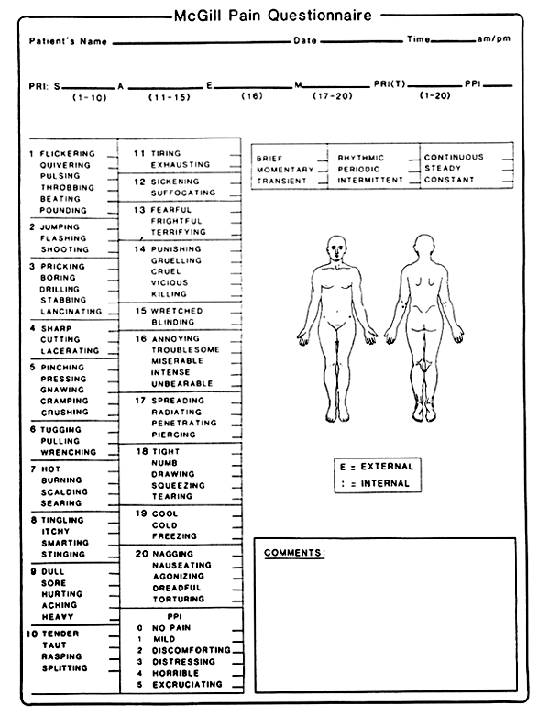Has a doctor ever asked you to rate your pain on a scale from one to ten?
Over 40 years ago, McGill University’s Dr. Ronald Melzack and Dr. Warren Torgerson set out to create a quantitative measure for pain—that is, a numerical scale to analyze the condition of patients.
“The McGill Pain Questionnaire consists primarily of three major classes of word descriptors—sensory, affective, and evaluative—that are used by patients to specify subjective pain experience,” Dr. Melzack wrote in the 1975 issue of The Journal of Pain. “It also contains an intensity scale and other items to determine the properties of pain experience.”
In other words, doctor asks their patients to select which words best reflect their pain levels and to assign each a number of intensity. The words patients select each have an assigned quantitative value on the survey, allowing the health care professional to calculate a number for their level of pain.
With the McGill Pain Questionnaire, doctors guide patients through a series of questions, asking them first to select a single word from each group and then circle a specific number of words in specific categories. ‘Pulsing’ and ‘quivering’—both sensory words—are in category one. ‘Agonizing’ and ‘torturing’—both emotional words—are in category 20. ‘Troublesome’—an evaluative term—is in group 16. A quantitative measurement for pain is derived from their selections, coupled with a numerical value given for the intensity of the pain experienced.
While the above adjectives seem to represent a variety of pain levels, other terms are more difficult to differentiate and quantify. For instance, how can ‘frightful’ and ‘horrible’ represent two different types of pain? What’s the difference between ‘nagging’ pain and ‘tiring’ pain? Although hospitals still use the McGill Pain Questionnaire today, many undeniable flaws have surfaced since its introduction in the 1970s.
Inherent shortcomings arise from translating subjective observations into quantitative measurements. A numerical scale, calculation, and ranking all vary based on the person’s past experiences. A mother with two children may consider childbirth a ‘10’—the worst pain imaginable, whereas a young girl with an ear infection might not be able to imagine any pain worse than what she is experiencing.
Most scientists and doctors agree that a less subjective measurement would be beneficial. No such test or questionnaire has yet to be published, but steps have been taken to pursue a less numerical method of categorization.
“There are lots of problems that come with trying to measure pain,” Professor Stephen McMahon of the London Pain Consortium told The Independent on Jan. 10. “I think the obsession with numbers is an oversimplification. Pain is not unidimensional. It doesn’t just come with scale […,] it comes with other baggage. How threatening it is, how emotionally disturbing, how it affects your ability to concentrate.”
However, turning this baggage into scientific data fit for analysis also poses many challenges, making the escape from a numerical system seemingly impossible. Dr. Adnan Al-Kaisy, head of the Pain Management and Neuromodulation Centre at Guy’s and St. Thomas’ Hospital in London, hopes that technology may uncover a way to measure varying types of pain.
“[We’re] trying to develop a tool […] which will give an accurate impression of how active or disabled they are, and tell us the cause of their pain from the way they sit or stand,” Al-Kaisy told The Independent.
Whether or not such a measuring device will be developed in the near future is unknown. However, as pain research continues at McGill’s Alan Edwards Centre for Research on Pain, there’s no reason why what began here can’t continue here. Perhaps the next McGill Pain Questionnaire won’t be a questionnaire at all; maybe it will be the McGill Pain Machine.







Both my feet burn like noodles or been stabbed in them and burns constantly morning and evening I just hurt bad
same